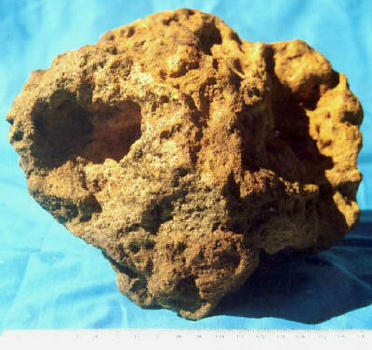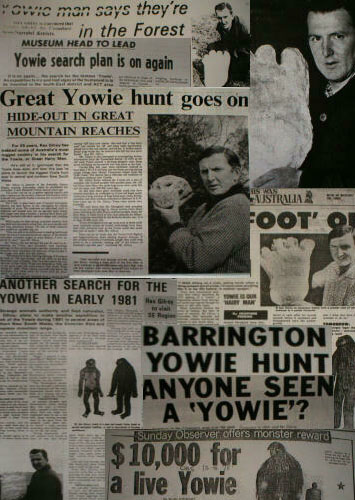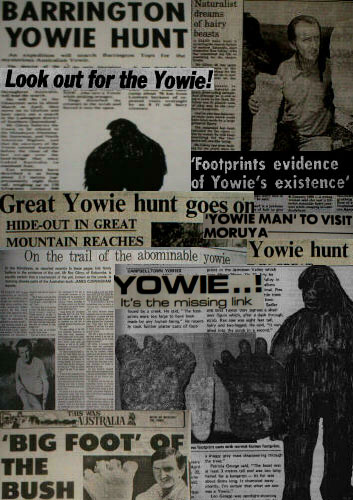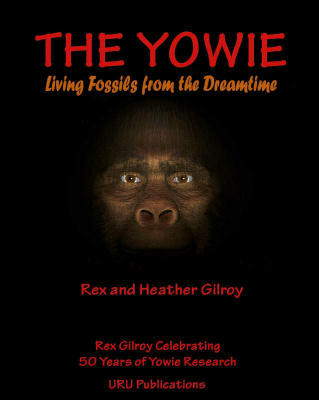Homo erectus in Australia
This article is composed of extracts from the 2007 book:
“The Yowie Mystery - Living Fossils From The Dreamtime".Copyright (c) 2007 Rex Gilroy, Uru Publications.
On Thursday 6th January 2005 while walking my dog ‘Cuddles’ [now deceased R.I.P] out on Narrow Neck Road, Katoomba, I chanced to notice a strangely-shaped ironstone rock projecting from the side of a bank, being a section of hillside cutting along the roadside, overlooking a swampy gully.
Curiosity got the better of me and I soon removed the rock from the gravel with a stick. It was then that I realised that the ‘rock’ was actually a badly weathered, although still recognisable, mineralised hominid skull!
The fossil had in fact come from the base gravels of the Pleistocene period ironstone strata which coats the Upper Blue Mountains. Below this was a basalt strata separating the Pleistocene [Ice-Age] deposits from the earlier Pliocene period. As the skull came from the very base of the Pleistocene deposits its age was unmistakable, as geologists have dated this strata to around 2 million years BP.
A close study of the fossil showed that it was distorted, the braincase having been crushed into the rear of the facial section. This I reasoned had occurred while the bones were still in a soft state early in the skull’s burial, before sediments were able to fill the skull’s vault to provide support against crushing by heavy overlying soil and rubble deposits.
Reconstruction of the specimen on paper later enabled me to be able to work out the original shape of the fossil. Firstly, by literally ‘pulling’ the braincase out it was soon obvious that the skull was a doliocephalic [ie long, narrow braincase] specimen, displaying ‘archaic’ that is, flattish cranial features Although part of the left cranial and eye socket section of the skull was missing, the right eye socket, and badly worn thick projecting brow ridge was present. An examination of the underside of the fossil revealed a badly weathered but recognisable dental arch, with faded tooth sockets barely visible.
The skull displayed a worn but suggested nasal passage and projecting muzzle. Yet there was one other feature of this fossil that I realised was unique, for its cranium still displayed a weathered, prominent sagittal crest. It looked like an archaic Homo erectus skull, yet it was far more primitive compared to others I had already unearthed elsewhere in Australia. For some time I studied and re-studied this badly deteriorated fossil, before coming to the realisation that what I had found, was more ‘proto’ Homo erectus than Homo erectus proper. I realised that I had discovered an immediate ancestor to ‘archaic’ Homo erectus.
The skull is filled with holes dug by ancient ground-dwelling insects when the skull bones had become softened by moisture during the first months of burial long ago. I also realised that, from the badly deteriorated condition of the fossil that it had become re-exposed on the surface at some stage in the dim past, suffering ages of weathering before finally becoming re-buried.
There was no doubt that this fossil was old, very old, and I reasoned that this particular race should extend back in time at least to the very late Pliocene period. However, the discovery of a proto-erectus skull suggested to me that Homo erectus, rather than developing outside Australia, probably evolved here first, eventually to evolve into the earliest modern humans, long before our first appearance in Africa. The oldest fossil remains of Javanese Homo erectus are, at our present knowledge, dated at 1.6 million years.
This Katoomba fossil suggests the erectus line far pre-dates the Java erectus fossil record and that older material awaits the Gilroys in Australia! ]For the past several years I had been finding numbers of crude Eolithic tools in the vicinity of the skull find, lying scattered about the dirt road and in the nearby scrub as they were gradually weathered to the surface by rain. I pondered that these ‘dawn tools’ belonged to some as yet unknown race of primitive Homo, but whom? Indeed, just four days before this discovery I had written in my latest anthropological exercise book the following prophetic theorising notes:
“He lurks ‘out there’ in the bushland in the form of fossil footprints pre-dating the early Pleistocene, the pre-Homo erectus era; and in the form of Eolithic tools so crude and weathered with ages of exposure to the elements, or [already] recovered from late Pliocene or “dawn Pleistocene” stratas. No skull type exists as yet for this mystery race. He is the pre-Homo erectus race from which Homo erectus [hypothetically] evolved, here in Australia.”
Little did I know that I would find my ‘dawn man’ four days after writing these notes! When this proto-erectus race lived, the deep gully below the road was a swamp around which the owner of the skull and others of its kind had settled, feeding upon the wide variety of animal and herbivorous food that was to be found in abundance hereabouts in those times. Other fossil finds in this area have shown that, among other life forms, a species of wombat was to be found here, as well as small tree-dwelling marsupials. Photograph right: Aboriginal Girl wearing a Kangaroo hide Garment. Photographer Unknown. I will credit anyone who owns this photograph.
There are also large flightless bird tracks to be found in this area, including fossil evidence that other, later early Homo shared this plateau. I measured the Katoomba proto-Homo erectus skull in its present state to be 20cm in length from projected muzzle to rear of braincase, by 17.5cm in depth at the front and 16cm at the rear of the braincase. The width of the skull was 21.5cm across the facial section. The right brow ridge was 2.5cm thick and the eye socket 6cm width by 3.5cm height. The sagittal crest, or rather what remained of it, was 7.5cm in length by 9cm width at the rear. I counted four faded sockets on the right side of the deteriorated dental arch and two on the left.
“Homo proto-erectus” as I have named ‘him’, I have estimated to have stood at least 1.6 metres tall. The skull appears very robust and therefore very probably that of a male of stocky build. Females of this race would perhaps have been somewhat smaller, say around 1.2 to 1.3 metres tall. They were probably of more slender appearance. When I uncovered this skull I thought I had found the oldest hominid fossil of its kind in Australia, but then I was yet to find the Bega district endocast
Some Australian scientists will even dismiss any apparent hominid fossils of ironstone or basalt, on the grounds that they would have to be ‘millions of years old’ and subsequently declare them to be similcras. Either such people are too frightened to identify them for what they are, or else they fear the academic dogmatic wrath of their “Out of Africa” and “Nobody before the Aborigines” thinking colleagues! To give one typical example here; one day in July 1988, Mr Jean Paul Buvet, then of Wentworth Falls, in the Blue Mountains east of Katoomba, stumbled upon a remarkable fossil while walking along a bush track near his home. A strangely shaped lump of red ironstone, he soon realised it to be an almost perfectly formed human foot, the size of a six year old child.
Anthropologist Mr Jim Specht of the Australian Museum, Sydney, later identified it as an endocast that had taken at least 200,000 years to form. However, Professor of Prehistory Richard Wright, of Sydney University was more sceptical. He was unable to bring himself to accept it as a human foot on the grounds that, being an ironstone specimen it would have to be [quote] “millions of years old”.
“Therefore I think it most unlikely that it is a human foot”, he told a reporter from the then Blue Mountains Echo newspaper.
The fact is that these supposed ‘experts’ don’t really know the answer to the mineralisation problem and so rather than admit they know very little in such matters, they cover themselves in a camouflaged protection of scientific language in the presence of gullible journalists and others, and dismiss the specimen concerned as nothing rather than admit that, despite all the impressive university degrees that they might have, they really know nothing about the subject that they claim to be authorities on!
By employing the old pre-Radiocarbon 14, British “positive dating” method it is possible for even an average amateur archaeologist to obtain satisfactory datings. This process involves the measuring and dating of the overlying gravel stratas in which a fossil or artefact etc is recovered, as it was worked out long ago that a 1.2 to 1.8 thick strata of gravels can be from at least 30,000 to 40,000 years in age. The above method coupled with an approximate 200,000 years [plus or minus 50,000] for limestone, mudstone or calcrete skeletal remains mineralisation often gives satisfying results, particularly when the particular fossil gives every indication of great age.
Often the known geology of the region, the age of a particular volcanic site when a fossil has been preserved in an ancient mud and ash flow [ie the Bega district skull endocast] etc, can be helpful in obtaining a reasonably accurate date.
We now enter the Homo erectus line proper, with a review of what we consider to be the skull-types most important to our argument, namely that Homo erectus was, and still is, the primitive Old Stone-Age race upon which the Yowie/”Hairy Man” traditions of our Aboriginal people were based.
It was about 5pm on Wednesday 24th October 2002 when Heather and I during the course of another Far North Queensland expedition, visited the Flinders River at Milgarra, which lies west of Karumba a few kilometres inland from the Gulf of Carpentaria. While we stopped on the east bank beside a bridge to photograph the river [which was almost bone dry due to the bad drought ravaging the countryside at that time], I made a quick inspection of the river bed gravels.
The sun was beginning to sink in the west as Heather called out to me to hurry as we had to leave for the east coast. Just before climbing into the car I made a quick dash into the roadside scrub to inspect some ironstone gravel from the east bank. As I had not found any fossils here I thought I might at least get a ‘souvenir’ rock as an example of the local red ironstone . Haphazardly grabbing a large lump from the top of a small pile, I returned to the car and we drove off.
The following morning, in the Motel room at Georgetown, I was washing dirt off the rock specimen when I suddenly found that the ‘lump’ of rock was a badly distorted, incomplete hominid skull! After showing Heather, I began recording this important find in my latest anthropological exercise book. I cradled that fossil in my hands all the way across country to the Atherton Tableland that day, so thrilled at my chance find! The specimen is badly distorted due to the usual effects of being buried at some depth and subjected to heavy sedimentary pressure upon softened bones through moisture in the sediments.
The pressure has subsequently flattened the right side of the specimen outwards somewhat and the brow ridges have broken away, with the nasal bones breaking away then re-attaching themselves to the mud that had filled the skull’s interior. At some stage the braincase has largely been lost. Lumps of mud have mineralised to the cranium, which is flattish. The muzzle area projects outwards. There is no lower jaw. The overall thinness of the skull bones suggests a female. Reconstruction of the available material shows the fossil to have been doliocephalic in structure. The skull suggests a rather slender individual of about 1.3m in height. The measurements made soon after the realisation that my Flinders River ‘souvenir rock’ was actually a mineralised skull, show the available length from front of muzzle to missing rear section to be 13.7cm, the width in its distorted state was 15cm, with a depth of 8cm. But how old was this fossil?
There was no doubt of this skull’s Homo erectus classification. The flattish cranium identified it as an ‘archaic’ specimen. The flat cranium gave way to the sloping forehead of the later evolving Homo erectines in Java around 1 million years ago. The fossil’s state of ironstone mineralisation certainly suggested this age. If this individual had not been born in Australia, she was certainly close enough to the beginning of the Australian end of the former great land shelf, that would have allowed earlier Homo erectines to migrate northwards, or else once having settled the Java area, later populations of ‘archaic’ erectus could have moved south, back into Australia.
Even if my theory of an Australian origin for Homo erectus is wrong, the evidence still shows that primitive races long before the time of Homo erectus were migrating southward into Australia. Yet we believe that the evidence we have already presented suggests an Australian genesis for Homo erectus and his ancestors. Although the ‘archaic’ flat cranium form of Homo erectus may have vanished in what is now Java by around 1 million years BP, this skull form appears to have lingered on for some time thereafter in Australia.
“The Yowie Mystery - Living Fossils From The Dreamtime".
“The Yowie Mystery - Living Fossils From The Dreamtime". Special Dedication. The Authors dedicate this book to the late Charles Melbourne Ward F.Z.S.; F.R.Z.S. known to his great many friends simply as ‘Mel’. Together with his wife Halley, he operated a natural history museum in the grounds of the Hydro Majestic Hotel at Medlow Bath for many years and also another established at Echo Point, Katoomba. It was ‘Mel’ who first taught me how to collect, record and study natural history specimens, beginning when I was aged 11 years old on holidays with my parents at Katoomba in 1954. Thereafter, every school holidays spent in Katoomba began with a visit to ‘Mel’ at his Medlow Bath Museum to inform him how my fledgling natural science studies were progressing!
As a result and after my parents moved from our Lansvale [western Sydney] home to Katoomba, the Gilroys and Wards became close friends. There was hardly a week which did not see me peddling my pushbike from our North Katoomba home up the Great Western Highway to see ‘Mel’ at his museum for more instruction. Mel Ward possessed a wide knowledge of the culture of the Australian Aborigines and that of the former local Blue Mountains tribes in particular.
He was also a firm believer in the “Hairy Man” and supported my researches in this regard. At my 21st birthday party, held at the Homesdale Function Centre, at Katoomba on Saturday night 8th November 1964, I well recall how my old friend, in front of a large gathering, congratulated me on my researches and the large natural science collection that I was forming and then said: “You’ve done a fantastic job Rex, BUT IT’S ABOUT TIME THAT YOU STARTED MAKING SOME BLOODY MONEY OUT OF IT” in a loud voice that brought the house down!
That following week, together with my father Mr W.F. [Bill] Gilroy, I began a search of local venues, which soon resulted in the acquisition of the lease from the Blue Mountains City Council of the Mt York Tea Rooms, outside Mt Victoria, the rest they as “is history”. Two years late, on October 6th 1966, Mel Ward was dead, having passed away in his sleep. He once said to my father that I was “the Mel Ward of Tomorrow” and I am certain that Mel would be pleased to know that I have indeed followed in his footsteps.
Mel led an adventurous life. The son of Hugh J. Ward, a famous Shakespearean actor of the early 20th century, Mel was encouraged to go on the stage by his father but Mel developed a passion for the natural sciences and his wealthy parents helped him become established. In his lifetime of achievement, Mel became recognised as a world authority on Crustaceans and an anthropologist. He was made a Fellow of the Royal Zoological Society of New South Wales and was pleased when I too became a member of the Society in 1963. He encouraged me, not long before his death, to take on the Presidency of the Society’s Entomological section, where I served for three years from 1966 to 1969.
That he achieved so many things in the course of his lifetime researches is remarkable, because like this author, he was an amateur with not one university degree to his name! I am certain that my old friend would be delighted at the fact that, together with heather, I am now writing and publishing book on the subjects he loved and on the Yowie in particular. He taught me never to blindly follow the textbook and dare to question dogmas and not be told what to think! I have certainly followed his advice. Knowing Mel Ward as I did I know he would wholeheartedly approve of the scientific approach of this book, therefore “Mel”
This Book is for You!
Rex Gilroy - Australian Yowie Research Centre, Katoomba, NSW.
Monday 25th June 2007I also present sensible advice to any future would-be Yowie investigators. The reader will also be awed at the great many discoveries my wife Heather and I have made in all our years together in the field. I feel privileged to be the founder of Yowie research and to have encouraged other, sensible researchers to follow my example. The search for surviving relict hominids in remote, hidden regions of the world, has been called the “last great search”, and it is both a fascinating and exciting one. Rex Gilroy may be contacted at the Australalian Yowie Research Centre, PO Box 202, Katoomba. NSW 2780. Ph 02 4782 3441 or email New Email Address as of June 2009 randhgilroy44@bigpond.com on or visit our website : http://www.mysteriousaustralia.com/ or http://www.australianyowieresearchcentre.com/ or http://www.rexgilroy.com/
Newspaper Articles on Rex Gilroy's Lifetime Search for the Australian Yowie
Newspaper Articles on Rex Gilroy's Lifetime Search for the Australian Yowie
Aboriginal/Koori Names for the Australian Yowie
To present the Yowie mystery in its proper context, relict hominid evidence from south-east Asia, New Guinea, other west Pacific Islands and New Zealand is revealed, demonstrating how the ancestors of these ‘manimals’ once spread out across the earth via land-bridges that formerly joined Australia/New Guinea/New Zealand with what is now island south-east Asia to the Asian mainland.
“Hairy man” was a name given by the Aborigines to any non-Aboriginal race with which they shared this continent, but the term centred primarily upon at least three basic forms. These forms were either the height of an average human being, an enormous man-like and also ape-like form. All were known by different names Australia-wide, but all meant either “hairy man” or “great hairy man”.






